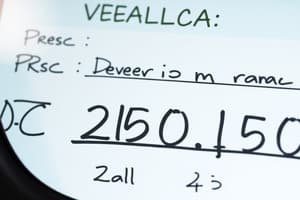Podcast
Questions and Answers
Which depreciation method is best suited for assets that lose their value more rapidly in the early years?
Which depreciation method is best suited for assets that lose their value more rapidly in the early years?
- Units of production method
- Depletion of natural resources method
- Straight-line depreciation
- Double declining balance depreciation (correct)
What is the primary factor that should be considered when choosing a depreciation method?
What is the primary factor that should be considered when choosing a depreciation method?
- The initial cost of the asset
- The estimated useful life of the asset
- The nature of the asset and its expected value decline pattern (correct)
- The tax implications of the chosen method
Which depreciation method is appropriate for assets that decline in value evenly over their useful life?
Which depreciation method is appropriate for assets that decline in value evenly over their useful life?
- Depletion of natural resources method
- Units of production method
- Double declining balance depreciation
- Straight-line depreciation (correct)
What is the primary purpose of the units of production method or depletion of natural resources method?
What is the primary purpose of the units of production method or depletion of natural resources method?
Which of the following statements is true regarding the importance of depreciation methods?
Which of the following statements is true regarding the importance of depreciation methods?
What is recommended when selecting a depreciation method?
What is recommended when selecting a depreciation method?
What is the primary difference between straight-line depreciation and double declining balance depreciation?
What is the primary difference between straight-line depreciation and double declining balance depreciation?
If a company purchases a machine for $20,000 and estimates its useful life to be 5 years, what would the annual depreciation be using the straight-line method?
If a company purchases a machine for $20,000 and estimates its useful life to be 5 years, what would the annual depreciation be using the straight-line method?
What is the formula for calculating double declining balance depreciation?
What is the formula for calculating double declining balance depreciation?
Which of the following is a key characteristic of double declining balance depreciation?
Which of the following is a key characteristic of double declining balance depreciation?
Which depreciation method would be most appropriate for a long-lived asset with a high salvage value?
Which depreciation method would be most appropriate for a long-lived asset with a high salvage value?
Flashcards are hidden until you start studying
Study Notes
Introduction
Depreciation is the process of allocating the cost of an asset over its useful life. It's an accounting method used by businesses to record the decreasing value of assets such as property, equipment or vehicles over time. This allocation is done through various methods, including straight-line depreciation, double declining balance depreciation, and others. In this article, we will discuss these methods in detail and compare them to help you understand the differences and similarities.
Straight-Line Depreciation
Straight-line depreciation is the simplest method of all depreciation methods. It is a method of accounting that allocates the cost of an asset over its useful life in equal periods. This means that each year, the asset is depreciated by the same amount. For example, if a company purchases a machine for $10,000 and estimates its useful life to be 4 years, then the annual depreciation would be $2,500.
Double Declining Balance Depreciation
Double declining balance depreciation is a method that allocates the cost of an asset over its useful life. However, it does so at a rate that is twice as fast as the straight-line method. This means that the asset is depreciated at a faster rate in the early years of its life, with a gradual decrease in the depreciation rate as the asset ages. The formula for double declining balance depreciation is [100 - (depreciation rate x 1)] / 100.
Depreciation Methods Comparison
When it comes to choosing a depreciation method, businesses must consider the nature of their assets and the rate at which they expect the asset to decline in value. While both straight-line and double declining balance depreciation allocate the cost of an asset over its useful life, they do so at different rates.
Straight-line depreciation is suitable for assets that decline in value evenly over their useful life, while double declining balance depreciation is better suited for assets that lose value more rapidly in the early years of their lives.
Another method commonly used for accounting for the cost of equipment and other long-term assets is units of production method or depletion of natural resources. This method records the cost of using up a resource or asset through its consumption rather than time.
In conclusion, understanding these different methods is crucial when it comes to managing and allocating costs associated with assets in any business environment. Depreciation plays a significant role in determining profitability, asset valuation, and financial reporting, so it is essential to choose the right depreciation method based on the specific nature of your assets. Always refer to your accountant or trusted advisor for guidance on selecting the most appropriate method for your situation.
Studying That Suits You
Use AI to generate personalized quizzes and flashcards to suit your learning preferences.




